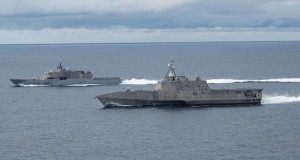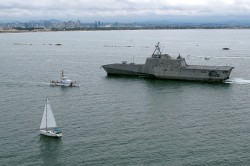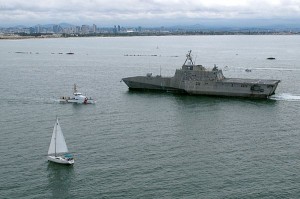My esteemed colleagues Kurt Albaugh and Matt Hipple made some interesting arguments about the U.S. Navy’s Littoral Combat Ship (LCS) in the past two days, although I disagree with each in different ways. At the risk of drowning our readers in the LCS debate, I’m going to make some brief remarks of my own and defer my own full analysis until I’m conflict-of-interest free, just so we can get it out of our system.
Mr. Albaugh highlighted a lot of good points about LCS. LCS is not meant to be the concept vessel formerly known as streetfighter and does a good job fulfilling a lot of low-intensity missions and niche combat roles. A less-threatening platform makes it easier to operate with partners in places like Africa, where cooperative engagement is more law-enforcement focused. And, as the Chinese and Philippine navies demonstrated by pulling out in favor of civilian vessels in the Scarborough Shoal, low-end ships can help ease tense stand-offs and prevent misunderstandings from escalating into conflicts. Few would like to see the U.S. and China in a dust-up, so there are benefits to be gained from the U.S. demonstrating to its partners a commitment to peacefully resolving maritime incidents.
However, I disagree with the argument that forward deploying only weak vessels will prevent China from hostility. As commentor Chuck Hill noted, being inoffensive does not always prevent aggression. In dealing with state actors like China with a “Realist, zero-sum view of the world,” more capability is likely a greater deterrent of aggression than a perception of weakness. While deploying only low capability ships in sensitive areas would limit China’s ability to claim a menacing U.S. naval presence as pretext for action, it would not prevent China from taking that action.
In addition to soft power missions like Pacific Partnership and America’s commitment to its value system, the influence the U.S. maintains in the Asia-Pacific region is in large part derived from its partners’ perceptions of defense assistance credibility. In a region with a rising power with uncertain intentions, purposefully choosing weakness lessens the United States’ influence with friends and potential foes alike.

The good news is I continue to disagree with Mr. Albaugh. LCS can actually be used as an offensive asset, clearing the way for power projection. And I disagree with Mr. Hipple that the ship was designed without a purpose or strategy in mind. The very example of China’s focus on anti-access/area-denial (A2/AD) capabilities are what drove LCS’ design. The three official mission packages – anti-submarine warfare, surface warfare, and mine-countermeasures – are all meant to fill counter-A2/AD capability gaps. And the ship itself, with its shallow draft, is meant to open access to U.S. forces in precisely that area of congested waters, the littorals, where most hostilities are expected to take place. This is the reason just purchasing multiple HSVs, as Juramentado and Mr. Hipple suggested, would not work. It is the same reason the National Security Cutter would not work.
This is not to say LCS can perform every mission of a destroyer or frigate – but that’s okay, that’s not what the Navy meant it or needs it to do. Nor is LCS perfect. Rather than risk-averse organization Mr. Hipple portrays, if anything, the Navy took too much risk on immature technologies for LCS’ mission packages, as Juramentado suggested. Budgets and politics also played a role in the program’s history. And sure, I would love to see a better anti-ship cruise missile, but this is a failing across the entire U.S. Navy, not confined to LCS. Learning from experience, capitalizing on feedback, and tweaking things like manning and mission package equipment will help.
There are still wrinkles in the LCS program, but a question of the role of LCS within the U.S. fleet remains only if the technologies that enable the originally intended missions do not come to fruition. That is no small wrinkle, but it is a different one than finding a strategy.



First, I like that we do these articles in waves. We bum rush a topic, beat it to death in a matter of days, then run off without leaving our license information.
Second, my disagreement isn’t with the level of the technology, but the investment in a capability. EA-6B Prowlers were a great investment due to their ability to completely dominate a section of warfare. I only noted those specific technologies because of their future potential and the risk-taking nature of investing in a “specialization.”
That said, if you compare the draft of LCS-2 with a South African Valour-class frigate or even an FFG-7, the difference is roughly 3 feet. The speeds are roughly the same as well. The weapons systems of he Valour are far greater minus the terrible hull problems.
LCS-1 comes off much better in the category of speed and draft, but has yet to overcome her vast structural and engineering problems. While the speed and draft might be great, a steady-state littoral craft needs far more reliability. An idea is only as good as the ability to execute.
CIMSEC got a hat tip at ID following all three of the LCS articles here. Bravo Zulu folks!
http://www.informationdissemination.net/2012/05/questionable-assumptions.html
-Armando
I prefer to think we pull it into an unmarked van, drug it, and leave it in an ice bath without an organ or two.
I’m not sure I follow your argument on specialization. You say the Navy needs to invest in “specialization” capabilities that “dominate a section of warfare.” That is exactly what LCS does. It is mission-focused on a particular warfare area depending on its mission package. One of the benefits of the risky introduction of modularity is that the Navy uses a single seaframe to be able to support whatever warfare area capability the operational commander needs, instead of designing separate ships from the ground up for each.
That said, there could be an argument that designing ships from the ground up for each would allow for greater optimization for each ship’s specialty (especially as it is unlikely there will be much need to ever conduct a mission package swap for operational requirements). However we can only speculate how the cost comparison would fall out – further complicated by the political decision to pursue two variants rather than down-select.
There are two other notable benefits of modularity. First, the ability to far more easily upgrade LCS, by swapping out the mission package with a fully upgraded replacement waiting at the pier –increasing the ship’s operational availability by eliminating the need to spend the time upgrading in dry dock or pierside. Second, the ability to use an existing seaframe to accomplish a completely different mission set as the strategic outlook or technology arises. Few predicted the dramatic rise in counter-piracy or drone operations 10 years ago. As Sherman commented on your post, it’s hard to hedge against an unknown future. Yet, LCS allows U.S. Navy planners to develop and deploy capabilities for warfighting areas needed now, while providing an opportunity for quick fleet introduction of future technologies and responses to new threats.
Again, that’s when everything works right. As I’ve said, there are wrinkles to work out. As the latest news from LCS shows, the manning concept and maintenance construct (ultimately driven by the manning concept) need work. But these are still early days for LCS’ operational experience, and there will be adjustments to both as more feedback and lessons learned come in.
(Full disclosure, I am a brownshoe and an ardent LCS skeptic)
It seems to me the whole concept of modularity presupposes that an adversary will be kind enough to present the LCS with only one type of threat at a time.
An LCS w/ASW package *MIGHT* be effective against enemy submarines. And an LCS w/SUW package *MIGHT* be effective against the small boat swarm. But either configuration is almost defenseless when faced with any other type of threat.
In my opinion, it’ll be very easy for a modern adversary to make an LCS completely irrelevent in a fight. There’s a huge capability gap between multi-purpose and multi-configuration.
@Hokie – I don’t disagree, there will likely be more than one threat at a time. The intention is not, for example, to have only LCS outfitted with ASW mission packages in one theater, and MCM MP in another. Instead there will be a mix, with each ship focusing on a specific mission to optimize its capabilities in that warfare area. This is why in anything beyond phase 0/1 operations I anticipate LCS will be operating in SAGs or with higher-end escorts.
That’s the theory anyway, which on its face doesn’t render LCS irrelevant in a fight. But it must be borne out by wargamming to see how effective this “netted” approach will be with these particular components.
@Scott C-P. If we’ve learned anything from history it is: (1) the enemy is generally the one who takes the first shot and (2) the transition from deterrence can can occur incredibly rapidly. See December 1941.
I think you and I agree that in order for LCS to be survivable in a modern battlespace once the shooting starts, it’s going to need large surface combatants (CGs/DDGs) for an escort.
Yet LCS was intended to take the strain off large surface combatants. If we need CG/DDG to ride shotgun for forward deployed LCS, aren’t we essentially no better than when we started?
Or are we truly going to forward deploy LCS alone and (un)afraid in harms way, knowing full well that once the balloon goes up they are largely expendable?
Gentlemen, hat tips to both of you, but more so to our readers who have weighed in on these posts. The only thing I’d like to add is a comment or two on an AOL Defense article published in the midst of our “bum rush.”
One quote grabbed me: “Nevertheless, Rowden said, ‘as we go forward with our R&D platforms and do some research and do some development, I think the need for speed will either show itself or, if it doesn’t, then perhaps we’ll go in a different direction.'”
I think the possibility that future LCS designs may reduce top speed represents a willingness to evolve the concept as we learn from the first ships. LCS could go in many directions – lower speed, more armament, more crew, or a combination of those. Is LCS a means to free up aegis ships for duty in the South China Sea or does LCS fill a role there as well? Strategy an tactics are rarely set in stone – they develop through an iterative process. It will be interesting to see how the class develops.
To allude to a previous, bloodied, shamed, and possibly no longer processing liquid waste post, we may be missing the forest on this. The question isn’t whether LCS is a good platform, it’s whether it should make the cut-off at a very exclusive party: Navy Shipbuilding Next Two Decades Night. The argument of its utility in an A2/AD scenario is on point to the degree that the LCS has enough general capabilities to fit the requirements of the current Hedge Everything national security strategy, but complaints about its lack of specification get more to the heart of a bigger question: is our national security strategy overly generic? And if it is, then the byproduct of limited resources is spending dollars on the wrong things. And that’s bad, to use a technical term.
FAC boats have missiles. Being near the coast means every vehicle and building could launch an anti-ship missile as well, just ask Israel.
Both are equipped with limited numbers of point defense RAM missiles. Point defense means your depth of fire is usually one. RAM usually shoots more than one missile in every engagement, and it is not possible to reload at sea on a smaller ship.
Both have different versions of relatively low powered rotating radars. Range and performance are less than optimal for ship defense. Rotating radar elements physically limits the radar’s ability to perform a kill evaluation.
This means a leaker will require another engagement, except there is no time for that when all you have is RAM.
Both have less than optimal soft kill abilities. Neither has 360 point defense.
Put all this together and they will get their a** shot in a missile war. It is 2012. Every war will be a missile war.
@Tim,
Valid points, but the question isn’t whether LCS can handle a high air-threat environment. It isn’t designed to and the Navy doesn’t claim otherwise.
The question is how much lead time indications and warnings will give the Navy to either assign LCS escorts if it needs LCS to complete its tasking, or to pull LCS back from the front (to sit things out, wait for an escort, or wait for a threat that it’s suited to counter (based on its mission package)). Note I don’t say to refit with a different MP, because unless the timeline of the conflict is in weeks or months, I don’t think the pieces for a swap will be in place.
It will also be a telling indication of the seriousness with which the Navy is taking a situation if we see LCS on independent operations re-tasked or given backup.
I honestly can’t believe anyone is still willing to defend the LCS with a straight face. The hulls are rotting to the waterline, their manning concept can’t even survive INSURV let alone a REAL DEPLOYMENT, they still have NO REAL WEAPONS TO SPEAK OF, no mission modules have delivered, the modules will likely not be interoperable with both hulls, the down-select was a FAILURE resulting in two hulls being bought, and sea state limitations are more severe than previously assumed.
Did I miss anything? So what capability do these ships actually bring? The CNO himself said it is not rated for combat, won’t see service in [contested] littorals, which is a good thing because these silly ships can’t withstand abusive language let alone serious surface action.
My recommendation to N96: contact the Singapore or Dutch Navies for a credible missile corvette design.
There’s a difference between flaws in concept and flaws in execution. The points you make speak of flaws in execution, while most of this debate has centered around the actual concept of LCS. For example, missile corvettes are fine if that’s what you want, but if you’re also looking for ASW and MCM capabilities, you’re not going to get that with those ships. As I’m sure you’d argue, the U.S. Navy’s not getting ASW or MCM capabilities with LCS sans mission packages either – sure – but that’s a different argument, flaws in execution.
Tim, your doctrine is inaccurate regarding RAM. 1 missile per engagement. RAM Blk 2 will have 2+ missiles. Can’t get into why here, but C-P knows me on the high side.